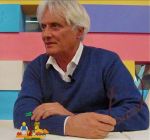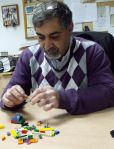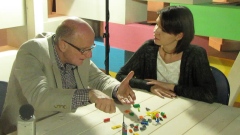Milena Kaneva is a smiling and bright person, a filmmaker and film director who in 2006 produced one of the most inspiring films about Burma, Total denial.
The main characters of her film are activists Ka Hsaw Wa and his wife, and they wanted to make the difference by documenting how Karen villagers had been treated in Burma. The case came from the building of a pipeline that Unocal, a former oil company, that was built next to the Andaman sea to connect Burma to Thailand: Karen villagers ‘who stood in the way to progress’ – to say it with the oil company’s managers words – have paid their opposition with all sort of human-right violations.
Ka Hsaw Wa engaged and led an 8 years lawsuit agains Unocal and 15 Karen vilagers sued Unocal for human-right abuses with the support of Burmese military.
This is an inspiring story, the story of the victory of Ka Hsaw Wa and the victory of Karen vilagers who have seen recognised their rights in an US court.
Milena has followed this story for 5 years, between 2000 – 2005. Milena’s career yet is not that of a ‘classic’ filmmaker or journalist: she started as an actress, but then her interest towards society and stories that can inspire people has taken the lead and, inspired by the Nobel Peace laureate Aung San Suu Kyi and lending the title of her book, she funded the Free from Fear Foundation. The foundation’s aim – as stated in the website ‘is to use the power of film, free media and other initiatives to educate and empower people about human rights and to denounce human rights violations everywhere. By telling the truth we remove the veil of fear.’
Something Milena already did and keeps doing, lending herself and her work to the cause of Burmese people and to those who are oppressed.
When She cames in, she is curious and excited – she immediately loved the concept of a LEGO based interview, and the whole interview had been a relaxed engaging and inspiring talk.
The filmmaker is a Tool. An interview with Milena Kaneva [+Video]
Jean-Philippe Tremblay: filmmaking is about the team [+ Video]
Jean-Philippe Tremblay is a Director/Writer, Producer and filmmaker. His latest work, Shadows of Liberty, costed him more than 5 years of work, and it has been presented in June at the Biografilm Festival and here is where I meet him.
Inspired by Ben Bagdikian‘s book “The New Media Monopoly” that in 1984 reported how media is controlled by only 5 conglomerate corporations, Shadows of Liberty is a true and sincere ode to freedom of information, where journalists tell their stories and present the difficulties they face to reveal the truth at any cost, going against the establishment. An inspiring documentary that shows and demonstrates that even today, regardless the corruption and the the power of corporations and governments that do their best – or their worst – to manipulate information and craft consent, there are still brave and hard-working individuals who investigate, research and reveal the facts and the truth. My interview with Jean-Philippe Tremblay could not be anything but about information. Yet, before getting into the real question, I also wanted to learn about what being a filmmaker means to him. And this is how we start.
What is filmmaking? I ask.
He immediately engages with the bricks with an open mind, like anyone who enjoys exploring and experimenting, he is one of those individuals who communicate life and experiences. He stares at the bricks and then he starts telling me the story.
Slavko Martinov: Filmmaking is ideas and questions
Slavko Martinov is a New Zealander film-maker who created an international case around his latest work, Propaganda: a documentary which presents Western society through the critical eyes of an anonymous North Korean professor. The professor is actually Mr Eugene Chang, a South Korean expat whose life has been completely changed by the attentions the movie has received by South Korean authorities, who accused Eugene to be a North Korean spy. The accusations lead to Eugene’s marginalisation and repudiation from the South Korean community in Christchurch, New Zeland, where he lives and where the documentary has been filmed and directed by Slavko Martinov and Mike Kelland. The idea of making a case has been a brilliant intuition, yet consequences went far beyond any expectation: the film mysteriously appeared on YouTube on 18th July 2012 as a documentary provided by North Korean defectors, and it circulated as anti-Western propaganda material originating from North Korea, before the truth around the film has been revealed.
During a round table at Biografilm Festival, Slavko admits that he would never imagined that his movie would have such an impact on members of his crew’s life, he expected consequences, but on himself. He worked with legal experts and was ready to face problems, but despite the public efforts Martinov and Kelland have been doing to clear Eugene name, the three of them are officially considered North Korean agent and Eugene’s life has been tuned upside down.
Colour exists by itself. It’s the human being who needs colour. LegoView with G. Cagnazzo.
Gianni Cagnazzo is an Architect. But that’s not enough to fully catch his polyhedric and enthusiastic attitude towards his job and his passions. Gianni Cagnazzo is president of IEM (Indoor Environment Management) and ANAB (National Association of Bio-ecological Architecture), member of the International Academy of Colour, he is professor in bio-ecological architecture, colour design and humanisation of the built space, he gives lectures at various institutes, including ANAB IBN (Institut fur Baubiologie und Oekologie – Neuberern), UNITRE, University of Turin… Colour is his passion, therefore the question was certainly due: What is colour?
He knows how my kind of interviews work and he starts building. When he is done, he explains me his model.
Palestine from the Israeli Perspective: an endless list of missed opportunities
Ariel is an Israeli professional, holds an MBA and has degrees in sociology, anthropology and Jewish history. He was born in Argentina and has been living in Israel since 1993. We met in Tel Aviv, on a sunny day at the end of December 2011. After we talked about Israel, it was time for me to see Palestine with his eyes.
‘Build me Palestine’ I ask him.
‘Palestinians… Palestinians…’ he sobs while building his model.
When he finishes, he looks at me:
‘This man is the Palestinian… they have peace in their mind…’
I look at the model and in the attempt to get a full vision of it and to take pictures I turn it so that the minifig could face me, but Ariel stops me. I am puzzled and ask ‘Why?’
‘This man is the Palestinian and he is looking toward the opposite direction, opposite to the way… They have peace in their mind, symbolised by the green bricks…’ he shows me ‘…they are dreaming about peace… No’ – he suddenly stops and corrects himself – ‘it’s not peace, they are dreaming about normalisation and about a free state, it’s not really peace… It’s like Egypt, we have peace with Egypt since 1981, it’s been 30 years. But that’s not real peace though. 10 years ago I went to Egypt, it was in 1991 and I didn’t feel peace like I do here, they don’t like us, let’s say. You won’t see Egyptians here. They don’t come here…’
Palestine’s existence depends on respect and on our children
I have met Dr Rauf Azar at Beit Sahour medical centre. He is the director of the clinic since 2005. The clinic is part of the Health Work Committees in Palestine, a no profit NGO which main goal is to provide health services to the inhabitants of occupied Palestinian territories, with a special focus on patients from marginalised groups, like poor people, women, children and people with special needs. ‘This centre was founded as a clinic’ Dr Azar says, ‘then it expended and became a day care surgery centre and we are on our way to establish here a small hospital for general and reconstructive surgery’. The reconstructive surgery will be the first hospital dealing with reconstruction and it will be the first one in the Palestinian territories and it will be developed in partnership together with the Department of Plastic and Reconstructive surgery in Bari (Italy) and with prof. Michele Pascone.
Then I go straight to the point, and ask Dr Azar What is Palestine?
He does not say a word for a while. Then he looks at the bricks and without even touching them, he firmly says ‘Palestine is nothing here…’.
Architecture comes in Black & White – LegoView with F. Valan [Part2]
Francesca Valan, an Italian industrial designer, is internationally considered one of the most passionate and experienced colour experts. One of the key problems, when it comes to colour and architecture, is that colour is something that architects add at the end of the design. She strongly disagrees on such an approach and after telling us, with the bricks, of course, what is colour, I asked her about Architecture. What is Architecture?
She stares at the bricks for a while and then she starts building. When she has finished, she looks at me
and at the bricks and recalling the question – what is Architecture? – she simply says: ‘Rules. Geometric rules. Axes. Vertical and horizontal axes. But the main thing, it’s depletion of chromatic and material elements in favour of formal elements.’
I look at her model: it’s an interesting one, as there are a number of elements and they are all detached. ‘What are these elements you have built here?’ I ask her.
‘Volumes. These are volumes and not architecture. The yellow one, for instance, it’s a solid build following formal criteria I do not know, with improper chromatic criterion. Because colour in architecture is always impoverished. It’s kind of too obvious, if there’s any logic, this is a trivialising one.’
Ciro Pirondi talks about Oscar Niemeyer
Ciro Pirondi is a Brazilian architect, director of the Escola da Cidade in São Paulo and friend and collaborator of Oscar Niemeyer. [Video]
Colour: the revolutionary emotional link. LegoView with F. Valan
Francesca Valan is an industrial Designer. People call her colour designer, but she doesn’t agree – she doesn’t like the concept that colour is something to be added to an object, an artifact or a building. She works with colours, as one of the most recognised colour experts in the world: her job is to define, understand and give colors the right shape and form, changing the perspective that generally considers colour as something added to an object as a finishing touch.
When I met her, I immediately wanted to interview her, not only because she is responsible for the current shade of green of our LEGO bricks, but because I really had no idea of what colour was.
She accepted – being a curious and creative person, she couldn’t resist the idea to explore the subject she devoted her career to in a new way. When we sit down, she pretends to be comfortable – we’ve been talking a lot of my idea and knowing how things proceed, she was getting ready for the unexpected.
I put the bricks in front of her and simply ask her: What is colour?
She knows how the process works, and she builds.
Architects’ challenge: Building ideas with LEGO bricks!
LEGO bricks to discover more about architecture and about architects’ mind and perception of reality. [Paesaggio Urbano 5-6/2012]
The relation between LEGO and Architecture is a longstanding one: as a response to the increasing attention to modern architecture in early 1960s, LEGO developed Scale LEGO with the ambition that architects and engineers would attempt scaling their models using LEGO.
But the relationship between Architecture and LEGO can go far beyond this historical link created by LEGO itself and it comes from a creative approach based on constructionist theories which have been developed in the 60s by Seymur Papert. Papert was among the first ones to adopt LEGO bricks as a learning tool in education and he capitalised on the strict relationship between hands and brain: it is well-know that hands are connected to between 70-80% of our brain cells, which means that through the exploitation of this neural connection people can learn and think more and in more creative ways by connecting their hands with their brain and by constructing something material. This is the assumption which lead in late ‘90s to the development of LEGO SERIOUS PLAY [LSP] a method used in organisations to help people to think, share ideas and creating teams, solve problems and define organisational strategies. This method was developed by Robert Rasmussen, at that time the director of product development for the educational market at LEGO and it was officially launched in January 2002.
[Read more]













